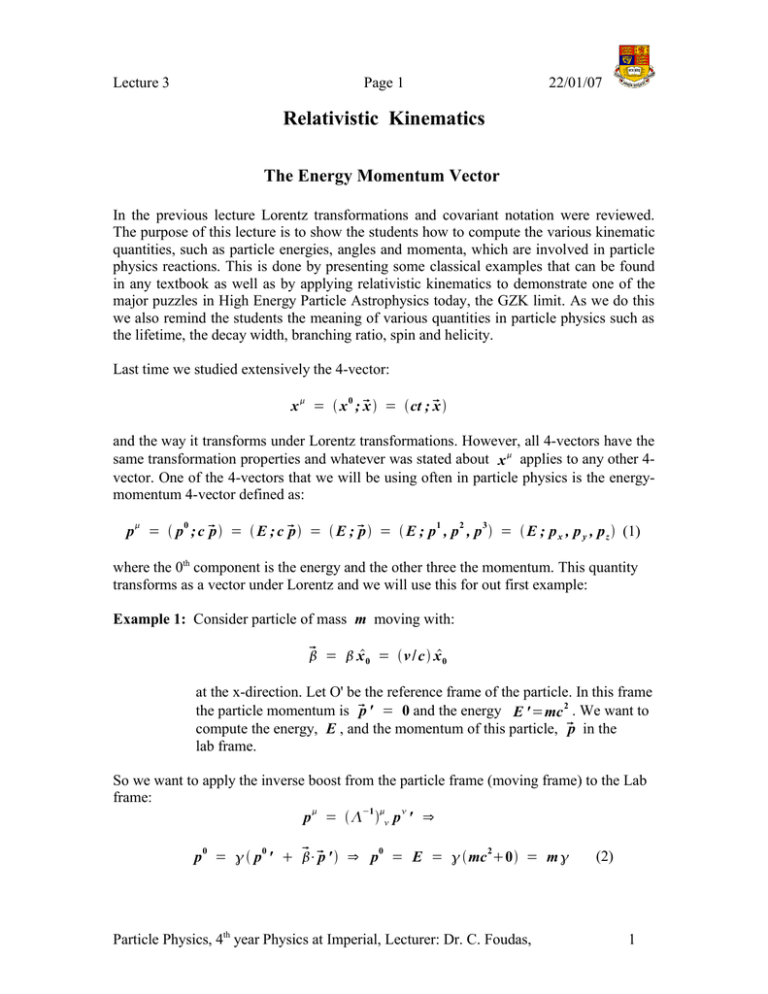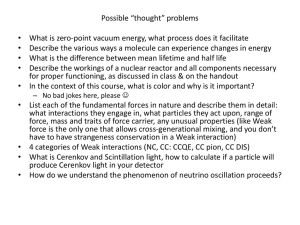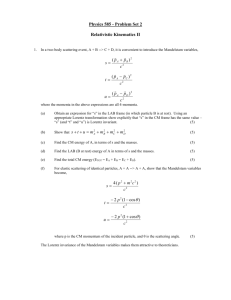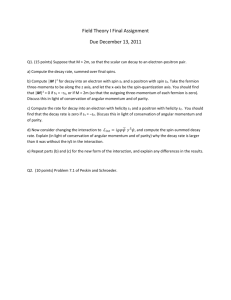Relativistic Kinematics The Energy Momentum Vector
advertisement

Lecture 3 Page 1 22/01/07 Relativistic Kinematics The Energy Momentum Vector In the previous lecture Lorentz transformations and covariant notation were reviewed. The purpose of this lecture is to show the students how to compute the various kinematic quantities, such as particle energies, angles and momenta, which are involved in particle physics reactions. This is done by presenting some classical examples that can be found in any textbook as well as by applying relativistic kinematics to demonstrate one of the major puzzles in High Energy Particle Astrophysics today, the GZK limit. As we do this we also remind the students the meaning of various quantities in particle physics such as the lifetime, the decay width, branching ratio, spin and helicity. Last time we studied extensively the 4-vector: 0 x = x ; x = ct ; x and the way it transforms under Lorentz transformations. However, all 4-vectors have the same transformation properties and whatever was stated about x applies to any other 4vector. One of the 4-vectors that we will be using often in particle physics is the energymomentum 4-vector defined as: p = p 0 ; c p = E ; c p = E ; p = E ; p1 , p 2 , p 3 = E ; p x , p y , p z (1) where the 0th component is the energy and the other three the momentum. This quantity transforms as a vector under Lorentz and we will use this for out first example: Example 1: Consider particle of mass m moving with: = x0 = v / c x0 at the x-direction. Let O' be the reference frame of the particle. In this frame the particle momentum is p ' = 0 and the energy E ' =mc 2 . We want to compute the energy, E , and the momentum of this particle, p in the lab frame. So we want to apply the inverse boost from the particle frame (moving frame) to the Lab frame: p = −1 p ' ⇒ p 0 = p0 ' ⋅p ' ⇒ p0 = E = mc 20 = m Particle Physics, 4th year Physics at Imperial, Lecturer: Dr. C. Foudas, (2) 1 Lecture 3 Page 2 22/01/07 p || = p || ' ∣∣⋅p 0 ' ⇒ p || = 0m = m (3) p⊥ = p⊥ ' = 0 In doing this we have shown the formulas for relativistic energy and momentum which students have already seen in special relativity courses. Two formulas that are used frequently are: 2 ⇒ = E m 3 ⇒ = p E Also 2 3 ⇒ p 2m 2 = m 2 m 2 = m 2 1 2 = m 2 2 E 2 = p 2m 2 Hence, (4) Example 2: Compute p ⋅p in any reference frame: We know from that the product p ⋅p is a Lorentz invariant so the easiest thing to do is to compute it in the particle rest frame where: p = m ; 0 ⇒ p ⋅p = m2 Of course one can also compute it in the lab frame using (4) p = E ; p ⇒ p⋅p = E 2−p 2 = m 2 Example 3: Pion Decay: Lifetime and decay length Consider a E =14 GeV negative pion which decays in to a muon and a muon anti-neutrino: . If the pion mass is m ≈ 140 MeV and the pion lifetime is ≈ 2.6 10−8 sec compute the lifetime of the pion in the lab frame as well as its decay-length. - First compute: = 14×10 3 MeV E = = 100 m 140 MeV Particle Physics, 4th year Physics at Imperial, Lecturer: Dr. C. Foudas, 2 Lecture 3 Page 3 22/01/07 The time dilation formula from special relativity gives: t LAB = = 100×2.6×10−8 = 2.6 sec This can be converted to decay length using: l LAB = c = 780 m Decay Rates, Life times and Branching Rations In the previous example we computed the decay length of the pion and found it to be 780m. This of course does not mean that after 780 m all pions will have decayed. It is well known that particle decays follow the radioactive decay law which states that after time, t, the number of particles that have survived is given by: N t = N 0e −t (5) where N 0 is the initial number of particles and is the particle lifetime defined in the particle rest frame. The effect of the interaction which causes the decay is hidden in the computation of the life time. This is what can be calculated using the theory that describes the particular decay. As was stated before the lifetime characterises in a sense the type of interaction involved and its coupling strength. For example, particles that decay via the weak interaction have by far longer lifetimes than particles that decay via the electromagnetic or the strong interaction. The decay width is defined as the inverse of the life-time and can be computed from the initial and final states of the reaction: = 1 2 ~ ∣< f ∣H INT∣ i >∣ Consider the case where a particle decays to different final states via n-different decay modes: f 1, f 2, f 3,. .. , f n . The total decay width can be computed as: : TOT = 1 2 3.... n Particle Physics, 4th year Physics at Imperial, Lecturer: Dr. C. Foudas, 3 Lecture 3 Page 4 22/01/07 To understand the meaning of the decay width we differentiate (5) and we have that: −t dN t −N t 1 1 dN t 1 = N 0 e −1 = ⇒ = −1 = − dt N t dt Hence, the decay width is simply the decay rate per particle. The branching ratio, B i , for a particular decay mode, i , is defined as the percentage of the particles decaying in this mode. Hence, Bi = i TOT Two body decay of a pion Consider again the decay of a pion to a muon and a muon anti-neutrino: - - We will use relativistic energy and momentum conservation to compute the energies and momenta of the final state particles given that: m ≈ 140 MeV , m ≈ 106 MeV , m ≈ 0 . It will be shown later in the course that this decay is described by the Feynman diagram in Figure 1. It is a decay the proceeds via the charged current weak interaction which is mediated by a massive charged spin-1 particle, the W. Figure 1: The Feynman diagram of a pion decaying to a muon and a muon anti-neutrino (right). Shown in the left is the decay products of the pion in the pion rest frame and in the laboratory frame. Particle Physics, 4th year Physics at Imperial, Lecturer: Dr. C. Foudas, 4 Lecture 3 Page 5 22/01/07 Let: P = m ; 0 , P = E ; P , P = E ; P be the energy momentum 4-vectors of the pion, muon and neutrino respectively in the pion rest frame. The decay kinematics are shown in Fig.1 (right). The outgoing particles are back-to-back in the pion rest frame in order to conserve momentum. Energy momentum conservation demands that: P = P P (1) Notice that the pion 4-vector is the simplest of all and any 4-vector dot-products that involve this 4-vector are bound to be also simple. So we move the neutrino 4-vector to the left side and square: 1 ⇒ 2 P − P = P P 2 P 2 −2 P P = m2 2 ⇒ P 2 P 2 −2 P ⋅P = m2 ⇒ m2 0−2 m⋅E = m2 ⇒ E = E = m 2−m2 2 m ⇒ ⇒ 140 MeV 2−106 MeV 2 ≈ 30 MeV 2×140 MeV Having computed the energy of the neutrino it is easy to find the momentum since the neutrino is assumed to be massless ∣P∣ = E ≈ 30 MeV .However, as shown in Fig. 1. the neutrino and the muon are emitted back-to-back in the rest frame of the pion and have momenta of equal magnitude because in this frame the initial particle, the pion, has zero momentum. Therefore: P =− P ⇒ ∣P∣ ≈ 30 MeV The muon energy can then be computed as: Particle Physics, 4th year Physics at Imperial, Lecturer: Dr. C. Foudas, 5 Lecture 3 Page 6 E= P2 m2 ≈ 3021062 MeV 22/01/07 = 110 MeV in the pion rest frame the muon has then an kinetic energy of: KE = 110 MeV −106 MeV = 4 MeV Figure 2: Pion decay signatures in emulsion. The pions lose energy and eventually stop in the emulsion material. Stopped pions decay to muons and neutrinos. The pions are the short tracks to the left which decay to a muon moving to the right and an invisible neutrino presumably to the left. The muons lose energy due to collisions and ionization while they move in the emulsion material and stop decaying to an electron and two neutrinos. All muons lose their kinetic energy by traveling the same distance because they have always the same energy to begin with. This is a proof that the charged pion decay is a two-body decay. Particle Physics, 4th year Physics at Imperial, Lecturer: Dr. C. Foudas, 6 Lecture 3 Page 7 22/01/07 The conclusion is that the energies and momenta of the final state particles in a two body decay are a function of the particle masses and have nothing to do with the nature of the underlying interaction the causes the decay. However, this fact was proven useful in determining that the pion decays via two body decay kinematics. The emulsion pictures in Fig. 2 demonstrate that the outgoing muon from the pion decay has fixed kinetic energy and of course fixed total energy which proves that the pion undergoes a two body decay. The explanation why is it so is the following: Muons from stopped pions, as they go through matter, lose energy via ionization and collisions. Hence, they will always travel the same distance from the pion decay point up to the point that they stop and decay themselves if they have the same energy to begin with. Information regarding the nature of the interaction itself can be obtained from the distributions of the decay products and the lifetime of the decay which as we saw before is directly related to the transition amplitude which can be calculated from interaction hamiltonian which is responsible for the specific decay. Isotropic decays A two body decay is defined to be isotropic if the number of decaying particles per unit solid angle is constant. In other words: dN = C where C is a constant d dN dN dN = = C ⇒ = −2 C sin d d cos d d (the minus sign coming from the fact that the cosine is increasing as the angel decreases). Therefore the isotropic decay distribution is flat in cos but not in . Particle Physics, 4th year Physics at Imperial, Lecturer: Dr. C. Foudas, 7 Lecture 3 Page 8 22/01/07 Figure 3: The differential decay rate of events observed as a function of cosθ (left) where the distribution is flat and as a function of θ (right) where the distribution is not flat. Helicity Define the helicity operator which is the projection of the spin at the direction of motion: H = s⋅p 1 = s⋅p where s = ∣p∣ 2 Hence, the eigenvalues of the helicity operator are: I. II. 1 for massive fermions. If the fermions are massless then, as we will see later in 2 the course, helicity and handedness are the same. Hence, in this case one can identify these states to left-handed and right-handed fermions. ± ±1, 0 for massive spin one objects. III. ±1 for massless spin one objects. Particle Physics, 4th year Physics at Imperial, Lecturer: Dr. C. Foudas, 8 Lecture 3 Page 9 22/01/07 Using helicity and angular momentum conservation one can make predictions regarding the spin of the decay products in a two body decay. As an example consider again the decay of a negative pion: , shown in Figure 4. Conservation of total angular momentum can be used to determine the spin of the outgoing negative muon. The spin of the pion spin has been measured in the 50s and was found to be zero. Also an experimental fact is that only positive helicity anti-neutrinos exist in nature (we will learn more on this when we discuss weak interactions). In the rest frame of the pion the total angular momentum is zero before the decay. The orbital angular momentum of the decay products is also zero. Hence, the spin of the negative muon must be opposite to that of the muon anti-neutrino. Hence, the muon must have also positive helicity. Figure 4: The helicity of the decay products of a negative pion. The anti-neutrino is right-handed because there are no left-handed anti-neutrinos in nature. This forces the muon to be also right-handed because the pion spin is zero. Particle Physics, 4th year Physics at Imperial, Lecturer: Dr. C. Foudas, 9 Lecture 3 Page 10 22/01/07 Reactions Information about the nature of interactions can also be obtained by measuring scattering cross sections. Example: I. Considering that the cosmic rays are mostly protons, compute the energy threshold for the reaction p p where a cosmic ray proton collides with a cosmic −3 microwave background (cmb) photon (3 K0 or E = 1.4×10 eV ) to produce a pion and a proton. II. The spectrum of the observed cosmic ray interactions by the HiRES and AGASA experiments as shown in Fig. 5. Assuming that the cross section above threshold for this reaction is p = 200 B and that the cosmic microwave background phton density is = 550 / cm 3 compute the mean-free-path for the comic ray protons and show that they could not possibly come from outside our galaxy. Figure 5: Cosmic ray data which demonstrates the existence of cosmic rays in the energy range above 1019 eV. The comic ray flux is shown on the y-axis and the energy on the x-axis. Particle Physics, 4th year Physics at Imperial, Lecturer: Dr. C. Foudas, 10 Lecture 3 Page 11 22/01/07 Solution: P P p = P P ' p ⇒ P P p 2 = P P ' p 2 ⇒ m 2 m2p 2 P P p = m2 m 2p 2 P P ' p (1) The threshold for this reaction is defined to be the energy where the outgoing proton and pion are just produced with zero kinetic energy whist the incoming photon and proton collide head-on. Therefore: 1 ⇒ m 2p 2 E E p − P⋅P p =m2 m2p 2 E E ' p −2 P⋅P' p The proton mass terms cancel and in any case at the energies involved the energy of the proton is equal to its momentum in GeV. Hence, 4 E E p =m2 2 E E ' p −2 P⋅P' p ⇒ (the momenta of the out-going pion and proton are zero so only the energies survive as masses) Ep = Ep = m2 2 m m p 4 E ⇒ 0.14022×0.140×0.940 ≈5×1019 eV −3 −9 4×1.4×10 ×10 So there is no doubt that this reaction can occur for the highest energy range particles which as shown in Fig. 5 have energies above the threshold energy. The mean free path for interaction is given by: = V A = N A×× Where A is the atomic weight, NA the Avogadro number, is the density and is the cross section of the interaction. In the second expression the quantity V represents the elementary volume occupied by a target quantum, in this case a cmb photon. Since the cross section and the number of photons per square centimeter is given we can use the second expression to compute the mean fee path: Particle Physics, 4th year Physics at Imperial, Lecturer: Dr. C. Foudas, 11 Lecture 3 = Page 12 6 −3 550 × 10 m 22/01/07 1 = 9.1 × 1022 m ⇒ −6 −28 2 × 200 × 10 × 10 m = 3 Mpc 6 1 pc = 3 × 10 m Hence, the mean free path due to this effect is smaller than intergalactic distances and the likelihood is that protons produced at distances larger than this will interact before the get to us and cannot be observed close to earth. This means that these high energy events at the tail of the distribution must have come from inside our galaxy and the big unanswered question is where do these particles come from. This is one of the hot questions investigated by todays astroparticle physics. The threshold energy we calculated is the famous Greisen, Zatsepin, Kuzmin (GZK) cut off. Particle Physics, 4th year Physics at Imperial, Lecturer: Dr. C. Foudas, 12









